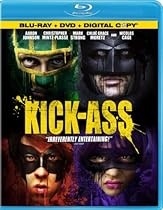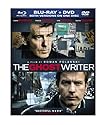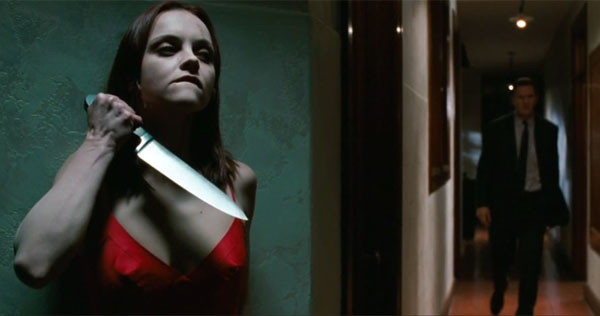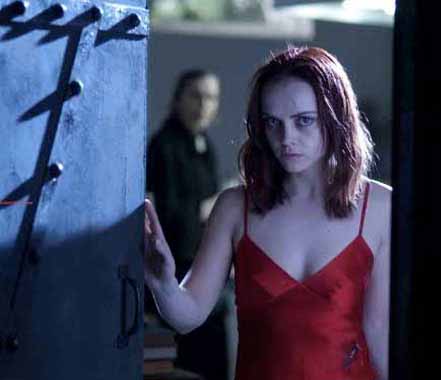
The week of Tuesday, August 3 offers a hidden bat cave full of horror, fantasy, and science fiction films on Blu-ray, DVD, and VOD – everything from contemporary costumed crime-fighters to Corman Cult Classics. Up first is Lionsgate’s release of KICK-ASS, starring Aaron Johnson, Christopher Mintz-Plasse, Mark Strong. Chloë Grace Moretz, Clark Duke, and Nicolas Cage. Available to rent or own via Video on Demand, KICK-ASS is also being offered on DVD and Blu-ray disc. The DVD is offered as stand-alone purchase and as part of the Blu-ray three-disk set, which also includes a digital copy of the film. Check out more details below:
BLU-RAY DISC SPECIAL FEATURES*
- Ass-Kicking Bonus View Mode (Blu-ray Disc Exclusive) – Synchronous with the feature film, this innovative multi-media presentation incorporates video and audio commentary, behind-the-scenes clips and illustrative graphics with Co-Writer/Producer/Director Matthew Vaughn, plus cast and crew providing an all-access perspective on Kick-Ass
- “A New Kind of Superhero: The Making of Kick-Ass ” documentary (Blu-ray Disc Exclusive)
- “It’s On! The Comic Book Origin of Kick-Ass” featurette
- Audio Commentary with Writer-Director Matthew Vaughn
- “The Art of Kick-Ass” gallery
- Marketing Archive
- BD Touch and Metamenu Remote
- Lionsgate Live™ enabled, featuring extra content for Internet-connected players
- Enhanced for D-Box™ Motion Control Systems
DVD SPECIAL FEATURES*
- Audio Commentary with Writer-Director Matthew Vaughn
- “It’s On! The Comic Book Origin of Kick-Ass” featurette
- “The Art of Kick-Ass” gallery
- Marketing Archive
*Subject to change

If that’s not enough superhero action for you, then check out HEROES: SEASON FOUR, available on DVD and Blu-ray disc. The DVD offers numerous four featurettes, deleted and extended scenes, a screen-saver gallery, and audio commentaries on the episodes “Once Upon a Time in Texas,” “Shadow Boxing,” “The Fifth Stage,” and “Brave New World.” The Blu-ray disc replicates these bonus materials along with bios on the characters and and additional feturette (“Behind the Big Top”), plus the usual array of interactive features for which the format is known: BD-LIVE, pocket BLU, Advanced Remote Control, Video Timeline, Mobile-To-Go, U-CONTROL, PICTURE-IN-PICTURE, and more.

THE GHOST WRITER also hits store shelves in DVD and Blu-ray editions. Though not a horror film, Roman Polanski’s excellent adaptation of the Robert Harris novel, is thematically consistent with the director’s classic horror films, ROSEMARY’S BABY and DANCE OF THE VAMPIRES. The story follows a ghost writer (Ewan McGregor) helping a former prime minister (Pierce Brosnan) write his memoirs; unfortunately, sinister forces are interested in the contents of the manuscript, whose previous ghost writer drowned under mysterious circumstances. THE GHOST WRITER generates more than enough paranoid tension to qualify as a “scary movie,” even if the scares are of the thriller variety.
 AFTER.LIFE – which stars Christina Ricci, Liam Neeson, and Justin Long – arrives on Blu-ray and DVD and having had a limited theatrical release earlier this year. Despite an intriguing premise, this morbid little indie horror film with art house aspirations is ultimately disappointing. Bonus features include a theatrical trailer, an interview with director Agnieszka Wojtowicz-Vosloo, and an eight-minute featurette somewhat pretentiously titled “Dwelling Into the After.Life: The Art of Making a Thriller.”
AFTER.LIFE – which stars Christina Ricci, Liam Neeson, and Justin Long – arrives on Blu-ray and DVD and having had a limited theatrical release earlier this year. Despite an intriguing premise, this morbid little indie horror film with art house aspirations is ultimately disappointing. Bonus features include a theatrical trailer, an interview with director Agnieszka Wojtowicz-Vosloo, and an eight-minute featurette somewhat pretentiously titled “Dwelling Into the After.Life: The Art of Making a Thriller.”

Roger Corman’s Cult Classics is at it again, offering elaborate DVD and Blu-ray releases of exploitation titles of the type that do not normally receive the lavish treatment. This time out we have PIRANHA on Blu-ray and a Lenticular Cover DVD, HUMANOIDS FROM THE DEEP on Blu-ray and DVD, and a double bill DVD of DEATH SPORT and BATTLE TRUCK. The later of is only marginal interest, but HUMANOIDS FROM THE DEEP deserves its place in history for taking the implications of old monster movies (which inevitably had the monster sweeping the leading lady off her feet) and seeing them through to their logical conclusion. Both Blu-ray disc features a new high-def transfer of the uncut international version; deleted scenes; trailers, TV and radio spots; an interview with producer Roger Corman; and a making-of featurette. The DVD duplicates the bonus material, with standard-def video quality.
 PIRANHA is one of the best films ever to come out of Corman’s New World Pictures, a fun and fast-paced horror thriller about scientifically altered killer fish, starring Bradford Dillman and Heather Menzies. (It is highly doubtful that the upcoming 3-D remake will be an improvement.). The film was previously the subject of a special edition DVD. The Blu-ray ports over the old features (audio commentary, behind-the-scenes footage, bloopers) and adds some new ones: a making-of featurette, still and poster galleries, radio and TV spots, and additional footage that was inserted into the version of the film broadcast on network television. As with HUMANOIDS FROM THE DEEP, the DVD duplicates the bonus features; both discs offer a new anamorphic widescreen transfer (1.85), but of course the Blu-ray features higher video quality.
PIRANHA is one of the best films ever to come out of Corman’s New World Pictures, a fun and fast-paced horror thriller about scientifically altered killer fish, starring Bradford Dillman and Heather Menzies. (It is highly doubtful that the upcoming 3-D remake will be an improvement.). The film was previously the subject of a special edition DVD. The Blu-ray ports over the old features (audio commentary, behind-the-scenes footage, bloopers) and adds some new ones: a making-of featurette, still and poster galleries, radio and TV spots, and additional footage that was inserted into the version of the film broadcast on network television. As with HUMANOIDS FROM THE DEEP, the DVD duplicates the bonus features; both discs offer a new anamorphic widescreen transfer (1.85), but of course the Blu-ray features higher video quality.
As for the rest:
- JAMES AND THE GIANT PEACH comes out in a new Blu-ray release that ports over the old DVD bonus features, adding only higher video quality and a new game.
- PANDORA AND THE FLYING DUTCHMAN, the 1951 film version of the classic story about the immortal sea captain, starring James Mason and Ava Gardner, arrives in a new Blu-ray release.
- I AM LEGEND is resurrected in an Ultimate Collector’s Edition Blu-ray set.
- A handful of other titles: METALSTORM: THE DESTRUCTION OF JARED-SYN; HOBOKEN HOLLOW (with Dennis Hopper); and OPEN HOUSE.
[serialposts]






